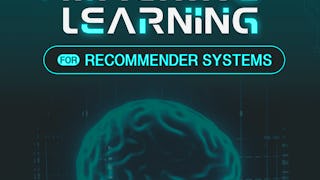The Basic Recommender Systems course introduces you to the leading approaches in recommender systems. The techniques described touch both collaborative and content-based approaches and include the most important algorithms used to provide recommendations. You'll learn how they work, how to use and how to evaluate them, pointing out benefits and limits of different recommender system alternatives.



(43 reviews)
Recommended experience
What you'll learn
You'll be able to build a basic recommender system.
You'll be able to choose the family of recommender systems that best suits the kind of input data, goals and needs.
You'll learn how to identify the correct evaluation activities to measure the quality of a recommender system, based on goals and needs.
You'll be able to point out benefits and limits of different techniques for recommender systems in different scenarios.
Skills you'll gain
Details to know

Add to your LinkedIn profile
4 assignments
See how employees at top companies are mastering in-demand skills


Earn a career certificate
Add this credential to your LinkedIn profile, resume, or CV
Share it on social media and in your performance review

There are 4 modules in this course
In this first module, we'll review the basic concepts for recommender systems in order to classify and analyse different families of algorithms, related to specific set of input data. At the end, you’ll be able to choose the most suitable type of algorithm based on the data available, your needs and goals. Conversely, you'll know how to select the input data based on the algorithm you want to use.
What's included
11 videos2 readings1 assignment1 peer review2 discussion prompts
In this second module, we'll learn how to define and measure the quality of a recommender system. We'll review different metrics that can be used to measure for this purpose. At the end of the module you'll be able to identify the correct evaluation activities required to measure the quality of a given recommender system, based on goals and needs.
What's included
12 videos1 assignment1 peer review2 discussion prompts
In this module we’ll analyse content-based recommender techniques. These algorithms recommend items similar to the ones a user liked in the past. We’ll review different similarity functions and you’ll then be able to choose the more suitable one for your system. The main input is the Item-Content Matrix (ICM) which describes all the attributes for each item. We’ll see how we can improve the quality of content-based techniques, by normalising and tuning the importance of each attribute in the ICM: you’ll be able to use some specific tuning strategies in order to obtain the best quality recommendations from your system. So, at the end of this module, you’ll know how to build a content-based recommender system, how to clean and normalize your input data.
What's included
9 videos1 assignment1 peer review2 discussion prompts
In this module we’ll study collaborative filtering techniques, which use the User Rating Matrix (URM) as the main input data, describing the interaction between users and items. We’ll learn how to build non-personalised recommender systems and how to normalise the URM, in order to provide better recommendations. At the end of the module you’ll be able to select the most appropriate similarity function and the most suitable way to compute similarity, overcoming issues related to explicit ratings.
What's included
9 videos1 assignment1 peer review2 discussion prompts
Instructor

Explore more from Data Analysis


EIT Digital


University of Minnesota


Sungkyunkwan University


University of Minnesota
Why people choose Coursera for their career




Learner reviews
43 reviews
- 5 stars
65.11%
- 4 stars
20.93%
- 3 stars
4.65%
- 2 stars
2.32%
- 1 star
6.97%
Showing 3 of 43
Reviewed on Oct 24, 2020
There is a nice introduction to recommender systems field
New to Data Analysis? Start here.

Open new doors with Coursera Plus
Unlimited access to 10,000+ world-class courses, hands-on projects, and job-ready certificate programs - all included in your subscription
Advance your career with an online degree
Earn a degree from world-class universities - 100% online
Join over 3,400 global companies that choose Coursera for Business
Upskill your employees to excel in the digital economy
Frequently asked questions
Access to lectures and assignments depends on your type of enrollment. If you take a course in audit mode, you will be able to see most course materials for free. To access graded assignments and to earn a Certificate, you will need to purchase the Certificate experience, during or after your audit. If you don't see the audit option:
The course may not offer an audit option. You can try a Free Trial instead, or apply for Financial Aid.
The course may offer 'Full Course, No Certificate' instead. This option lets you see all course materials, submit required assessments, and get a final grade. This also means that you will not be able to purchase a Certificate experience.
When you enroll in the course, you get access to all of the courses in the Specialization, and you earn a certificate when you complete the work. Your electronic Certificate will be added to your Accomplishments page - from there, you can print your Certificate or add it to your LinkedIn profile. If you only want to read and view the course content, you can audit the course for free.
If you subscribed, you get a 7-day free trial during which you can cancel at no penalty. After that, we don’t give refunds, but you can cancel your subscription at any time. See our full refund policy.
More questions
Financial aid available,




